Historic sites and monuments in Antarctica
A Historic site or monument ( English Historic Site or Monument , HSM) is a protected site of historical interest in the continent Antarctica or on one of the islands. The list of historic sites was first drawn up in 1972 and has since expanded to 85 sites. The newest properties have been listed since 2013. Five sites have been removed from the list for various reasons.
criteria
Historic sites and monuments are protected as one of three classes of Antarctic Protected Areas under the Antarctic Treaty . Items must meet one or more of the following criteria to be included in the list:
- A special, historical event took place at this location.
- The place is related to an important figure in Antarctic history.
- The place is related to a major feat of "perseverance or success".
- It stands for a larger activity "important for the development and knowledge of the Antarctic".
- The building itself is of technical, historical, cultural or architectural importance.
- The place has educational potential through "significant human activity" in Antarctica.
- It has symbolic value to the people of many nations.
The signatory states of the Antarctic Treaty are entitled to make proposals. The annual Antarctic Treaty Consultative Meeting (ATCM), together with the Committee for Environmental Protection (CEP), which meets at the same time, makes a decision about inclusion in the list of historical sites and monuments.
List of historical sites and monuments
![]() Map with all coordinates: OSM | WikiMap
Map with all coordinates: OSM | WikiMap
| photo | number | Surname | description | protected by | Location |
|---|---|---|---|---|---|
| HSM-01 | Flagpole at the geographic south pole | Flagpole at the geographic South Pole , erected in December 1965 by the first Argentine overland polar expedition. | Rec VII-9 | geographic south pole 90 ° 0 ′ 0 ″ S, 0 ° 0 ′ 0 ″ E |
|
| HSM-02 | Fukushima cairn | Cairns and plaques at the Shōwa station in memory of Shin Fukushima, a member of the fourth Japanese research expedition to Antarctica, who died in the course of his official duties in October 1960. The mound was erected by his colleagues on January 11, 1961. Part of his ashes rests in the mound. | Rec VII-9 |
East Ongul Island 69 ° 0 ′ 0 ″ S, 39 ° 35 ′ 0 ″ E |
|
| HSM-03 | Mawson's Stone Mound, Proclamation Island | Stone mound and plaque on Proclamation Island , Enderbyland , erected in January 1930 by Sir Douglas Mawson . The mound and the plaque serve to commemorate the landing of Sir Douglas Mawson and a group of the British, Australian and New Zealand research expeditions in Antarctica 1929–1931 (BANZARE) on Proclamation Island. | Rec VII-9 | Proclamation Island 65 ° 51 ′ 0 ″ S, 53 ° 41 ′ 0 ″ E |
|
| HSM-04 | Station building at the pole of inaccessibility | Station building to which a bust of Vladimir Ilyich Lenin is attached, with a plaque commemorating the conquest of the Pole of Inaccessibility by Soviet Antarctic explorers in 1958 | Rec VII-9 | Pole of Inaccessibility 83 ° 6 ′ 0 ″ S, 54 ° 58 ′ 0 ″ E |
|
| HSM-05 | Mawson's cairn, Cape Bruce | Stone mound and plaque in Cape Bruce , Mac Robertson Land , erected by Sir Douglas Mawson in February 1931. The mound and the plaque serve to commemorate the landing of Sir Douglas Mawson and a group of the British, Australian and New Zealand research expeditions in Antarctica 1929–1931 ( BANZARE ) at Cape Bruce. | Rec VII-9 | Cape Bruce 67 ° 25 ′ 0 ″ S, 60 ° 47 ′ 0 ″ E |
|
| HSM-06 | Wilkins' cairn | Stone mound at Walkabout Rocks , Vestfoldberge , Princess Elisabeth Land , built in 1939 by Sir Hubert Wilkins . The hill holds a container with a record of Sir Hubert Wilkins' visit. | Rec VII-9 | Walkabout Rocks 68 ° 22 ′ 0 ″ S, 78 ° 33 ′ 0 ″ E |
|
| HSM-07 | Ivan Chmara Stone | Stone with an inscribed plaque, erected on Buromski Island in memory of the driver and motor vehicle mechanic Iwan Chmara (1936–1956), participant of the first Soviet Antarctic expedition, who died on the sea ice on January 21, 1956 while fulfilling his official duties. The stone originally stood at Mirny Station , Mabus Point , but was moved in 1974. | Rec VII-9 | Buromski Island 66 ° 32 ′ 4 ″ S, 92 ° 59 ′ 57 ″ E |
|
| HSM-08 | Anatoly Shcheglov Monument | Metal sled as a memorial on the route between the Mirny and Vostok stations , two kilometers from Mirny, with a memorial plaque in memory of the driver and motor vehicle mechanic Anatoly Shcheglow, who perished on February 25, 1962 while fulfilling his official duties. | Rec VII-9 |
Mabus Point 66 ° 34 ′ 43 ″ S, 92 ° 58 ′ 23 ″ E |
|
| HSM-09 | Buromsky Island cemetery | Cemetery on Buromsky Island near Mirny Station , where participants of Soviet Antarctic expeditions from different countries are buried | Rec VII-9 | Buromski Island 66 ° 32 ′ 4 ″ S, 93 ° 0 ′ 0 ″ E |
|
| HSM-10 | Soviet Oasis Station Observatory | Magnetic observatory in Dobrowolski station, Bunger-Oase , with a plaque commemorating the opening of the oasis station in 1956 | Rec VII-9 | Bunger oasis 66 ° 16 ′ 0 ″ S, 100 ° 45 ′ 0 ″ E |
|
| HSM-11 | Vostok station tractor | Heavy tractor AT-T No. 11 on the Vostok station , Wilkesland , with a plaque commemorating the opening of the station in 1957 | Rec VII-9 | Vostok Station, Wilkesland 78 ° 28 ′ 0 ″ S, 106 ° 48 ′ 0 ″ E |
|
| HSM-14 | Ice cave on Inexpressible Island | Ice cave on Inexpressible Island , Terra Nova Bay , built in March 1912 by the northern group of Victor Campbells (1875–1956), Terra Nova Expedition 1910–1913 . The group spent the winter of 1912 in this ice cave. There is a wooden sign, a plaque and seal bones by the ice cave. | Rec VII-9 | Inexpressible Island 74 ° 54 ′ 0 ″ S, 163 ° 43 ′ 0 ″ E |
|
| HSM-15 | Shackleton's hut | Hut at Cape Royds , Ross Island , built in February 1908 by the Nimrod Expedition from 1907 to 1909 under the leadership of Sir Ernest Shackleton , restored in January 1961 by the Antarctic Department of the New Zealand Department of Scientific and Industrial Research. The hut is part of the Antarctic Specially Protected Area ASPA-157. | Rec VII-9 | Ross Island 77 ° 33 ′ 0 ″ S, 166 ° 10 ′ 0 ″ E |
|
| HSM-16 | Terra Nova hut | Hut on Cape Evans , Ross Island, built in January 1911 by the British Terra Nova Expedition 1910–1913 under the leadership of Captain Robert Falcon Scott . Restored in January 1961 by the Antarctic Division of New Zealand's Department of Scientific and Industrial Research. The hut is part of the special Antarctic protected area ASPA-155. | Rec VII-9 | Ross Island 77 ° 38 ′ 0 ″ S, 166 ° 24 ′ 0 ″ E |
|
| HSM-17 | Cross on the Wind Vane Hill | Cross on Wind Vane Hill , Cape Evans, Ross Island, built by Captain Aeneas Mackintosh led Ross Sea Group of Endurance Expedition 1914-1916 Ernest Shackleton in memory of three members of the group died in 1916 nearby. The cross is part of the special Antarctic protected area ASPA-155. | Rec VII-9 | Cape Evans, Ross Island 77 ° 38 ′ 0 ″ S, 166 ° 24 ′ 0 ″ E |
|
| HSM-18 | Scott's Discovery Hut | Hut at Hut Point , Ross Island, built in February 1902 by the British Discovery Expedition 1901–1904 under the leadership of Captain Robert Falcon Scott. Partly restored in January 1964 by the New Zealand Antarctic Society with assistance from the United States Government. The hut is part of the special Antarctic protected area ASPA-158 | Rec VII-9 | Hut Point, Ross Island 77 ° 50 ′ 0 ″ S, 166 ° 37 ′ 0 ″ E |
|
| HSM-19 | George Vince Cross | Cross at Hut Point , Ross Island, erected in February 1904 by the British Discovery Expedition 1901–1904 in memory of George T. Vince (1879–1902), a member of that expedition who died nearby. | Rec VII-9 | Hut Point, Ross Island 77 ° 50 ′ 0 ″ S, 166 ° 37 ′ 0 ″ E |
|
| HSM-20 | Cross on Observation Hill | Cross on Observation Hill , Ross Island, erected in January 1913 by the British Terra Nova Expedition 1910–1913 in memory of Captain Robert Falcon Scott's group who perished on the way back from the South Pole in March 1912. | Rec VII-9 | Observation Hill, Ross Island 77 ° 51 ′ 0 ″ S, 166 ° 41 ′ 0 ″ E |
|
| HSM-21 | Wilson's stone hut | Remains of a stone hut on The Knoll Hill , Cape Crozier , Ross Island, built in July 1911 on the occasion of the winter march of Edward Wilson's group of the Terra Nova Expedition, which was used to collect eggs from the emperor penguins . | Rec VII-9 | Cape Crozier, Ross Island 77 ° 31 ′ 0 ″ S, 169 ° 22 ′ 0 ″ E |
|
| HSM-22 | Borchgrevinks huts | Three huts and associated historical relics at Cape Adare . Two of the huts were built in February 1899 during the Southern Cross Expedition 1898-1900 under the direction of Carsten Egeberg Borchgrevink . The third hut was built in February 1911 by the northern group of the Terra Nova Expedition led by Victor Campbell. It has largely collapsed, in 2002 only the porch was left. The three huts are part of the special Antarctic protected area ASPA-159. | Rec VII-9 | Cape Adare 71 ° 18 ′ 0 ″ S, 170 ° 12 ′ 0 ″ E |
|
| HSM-23 | Hanson's grave | Grave of the Norwegian biologist Nicolai Hanson , a member of Carsten Egeberg Borchgrevink's Southern Cross Expedition 1898–1900 at Cape Adare . A large stone marks the head end of the grave, the outlines of which are marked by white quartz stones. A cross and a plaque are attached to the stone. | Rec VII-9 | Cape Adare 71 ° 17 ′ 0 ″ S, 170 ° 13 ′ 0 ″ E |
|
| HSM-24 | Amundsen's cairn | Stone mound on Mount Betty , Queen Maud Mountains , built by Roald Amundsen's South Pole Group on January 6, 1912 on their way back from the Pole to Framheim . | Rec VII-9 | Mount Betty 85 ° 11 ′ 0 ″ S, 163 ° 45 ′ 0 ″ W. |
|
| HSM-26 | abandoned San Martín station | Abandoned facilities of the Argentine General San Martin Station on Barry Island , Debenham Islands , Marguerite Bay , with cross, flagpole and monolith, built in 1951. | Rec VII-9 | Barry Island 68 ° 8 ′ 0 ″ S, 67 ° 8 ′ 0 ″ W |
|
| HSM-27 | Charcot's cairn (1909) | Stone mound with a replica of a memorial plaque on Megalestris Hill on Petermann Island , erected in 1909 by the second French expedition led by Jean-Baptiste Charcot . The original of the memorial plaque is in the holdings of the Muséum national d'histoire naturelle in Paris. | Rec VII-9 |
Petermann Island 65 ° 10 ′ 0 ″ S, 64 ° 9 ′ 0 ″ W |
|
| HSM-28 | Charcot's cairn (1904) | Stone mound near Port Charcot , Booth Island , with a wooden column and plaque with the names of the participants of the first French expedition led by Jean-Baptiste Charcot, who wintered here in 1904 on board the Français . | Rec VII-9 | Port Charcot, Booth Island 65 ° 3 ′ 0 ″ S, 64 ° 1 ′ 0 ″ W |
|
| HSM-29 | "Primero de Mayo" lighthouse | Lighthouse "Primero de Mayo" ( German May 1st ) on the Lambda Island , Melchior Islands , built by Argentina in 1942. It is the first Argentinean lighthouse in the Antarctic. | Rec VII-9 | Lambda Island, Melchior Islands 64 ° 18 ′ 0 ″ S, 62 ° 59 ′ 0 ″ W |
|
| HSM-30 | Refuge "Gabriel González Videla" | Refuge in Paradise Harbor , built in 1950 near the Chilean Gabriel González Videla Station in honor of Gabriel González Videla , the first head of state to visit Antarctica. The shelter is a representative example of activities prior to the International Geophysical Year 1957/58 . | Rec VII-9 | Paradise Harbor 64 ° 49 ′ 0 ″ S, 62 ° 51 ′ 0 ″ W. |
|
| HSM-32 | Monolith near Arturo Prat Station | Concrete monolith erected in 1947 near Arturo Prat Station on Greenwich Island , South Shetland Islands . Reference point for Chilean hydrographic studies in Antarctica. The monolith is a representative example of activities prior to the International Geophysical Year 1957/58 and is currently being maintained by the staff of the Arturo Prat Station. | Rec VII-9 | Greenwich Island, South Shetland Islands 62 ° 28 ′ 0 ″ S, 59 ° 40 ′ 0 ″ W |
|
| HSM-33 | González Pacheco refuge | Refuge and cross with plaque near Arturo Prat Station on Greenwich Island, South Shetland Islands. Named in memory of Corvette Captain Pedro González Pacheco (1922–1961), who tragically died as head of the station in 1960. | Rec VII-9 | Greenwich Island, South Shetland Islands 62 ° 29 ′ 0 ″ S, 59 ° 40 ′ 0 ″ W |
|
| HSM-34 | Arturo Prat bust | Bust of the Chilean sea hero Arturo Prat , erected in 1947 on the station of the same name on Greenwich Island, South Shetland Islands. The bust is representative of activities prior to the International Geophysical Year and has symbolic meaning in connection with the Chilean presence in Antarctica. | Rec VII-9 | Greenwich Island, South Shetland Islands 62 ° 50 ′ 0 ″ S, 59 ° 41 ′ 0 ″ W |
|
| HSM-35 | Statue of the Virgin of Carmen | Wooden cross and statue of the Virgin of Carmen , erected in 1947 near Arturo Prat Station on Greenwich Island, South Shetland Islands. The site is representative of activities prior to the International Geophysical Year and has particular symbolic and architectural value. | Rec VII-9 | Greenwich Island, South Shetland Islands 62 ° 29 ′ 0 ″ S, 59 ° 40 ′ 0 ″ W |
|
| HSM-36 | Memorial plaque for the Dallmann expedition | Replica of a metal plaque in Potter Bay , King George Island , erected by Eduard Dallmann to commemorate the visit of his German expedition on March 1, 1874 on board the Groenland . | Rec VII-9 | Potter Bay, King George Island 62 ° 14 ′ 0 ″ S, 58 ° 39 ′ 0 ″ W |
|
| HSM-37 | Bernardo O'Higgins historical site | The historic site at Cape Legoupil , Antarctic Peninsula , includes the following structures of historic value:
|
Rec VII-9 | Cape Legoupil 63 ° 19 ′ 0 ″ S, 57 ° 54 ′ 0 ″ W. |
|
| HSM-38 | Nordenskjöld's hut | Wooden hut on Snow Hill Island , built in February 1902 by the Swedish Antarctic Expedition under the direction of Otto Nordenskjöld . | Rec VII-9 | Snow Hill Island 64 ° 22 ′ 0 ″ S, 56 ° 59 ′ 0 ″ W |
|
| HSM-39 | Hope Bay Hut | Stone hut on Hope Bay , Trinity Peninsula , built in January 1903 by a group from the Swedish Antarctic Expedition. | Rec VII-9 | Hope Bay, Trinity Peninsula 63 ° 24 ′ 0 ″ S, 56 ° 59 ′ 0 ″ W |
|
| HSM-40 | General San Martín bust | Bust of General José de San Martín , grotto with a statue of the Virgin of Luján and flagpole on Esperanza Station , Hope Bay, erected in 1955 by Argentina; next to it a cemetery with a statue in memory of members of Argentine expeditions who perished in the area. | Rec VII-9 | Hope Bay, Trinity Peninsula 63 ° 24 ′ 0 ″ S, 56 ° 59 ′ 0 ″ W |
|
| HSM-41 | Pauletinsel Hut | Stone hut on Paulet Island , Antarctic Peninsula, built in February 1903 by Carl Anton Larsen , the Norwegian captain of the stranded ship Antarctic of the Swedish Antarctic Expedition under the direction of Otto Nordenskjöld, with the grave of a member of the expedition and one of the survivors of the shipwreck at the highest point The island's stone mound was built to attract the attention of rescue expeditions. | Rec VII-9 | Pauletinsel 63 ° 34 ′ 0 ″ S, 55 ° 45 ′ 0 ″ W. |
|
| HSM-42 | Scotia Bay huts | In the area of Scotia Bay , Laurie Island , South Orkney Islands there is a stone hut built in 1903 by the Scottish National Antarctic Expedition under William Speirs Bruce , an Argentine meteorological hut and an Argentine magnetic observatory, built in 1905 and known as "Moneta House", and a cemetery with twelve graves, the oldest of which dates from 1903. | Rec VII-9 | Laurie Island, South Orkney Islands 60 ° 46 ′ 0 ″ S, 44 ° 40 ′ 0 ″ W |
|
| HSM-43 | General Belgrano Cross | Cross, erected in 1955 at a distance of 1300 m northeast of the Argentinean Belgrano I station and relocated to the Belgrano II station , Bertrab-Nunataks , Coatsland in 1979 | Rec VII-9 | Bertrab-Nunataks, Coatsland 77 ° 52 ′ 0 ″ S, 34 ° 37 ′ 0 ″ W |
|
| HSM-44 | Dakshin Gangotri memorial plaque | Memorial plaque erected on the makeshift Indian Dakshin Gangotri Station, Princess Astrid Coast , Queen Maud Land, with the names of the participants of the first Indian Antarctic expedition, which landed nearby on January 9, 1982. | Rec XII-7 | Princess Astrid Coast 70 ° 45 ′ 0 ″ S, 11 ° 38 ′ 0 ″ E |
|
| HSM-45 | Gerlache expedition memorial plaque | Memorial plaque on the Brabant Island , Metchnikoff Point , erected at a height of 70 m on the crest of the moraine that separates this point from the glacier . The plaque bears the following inscription: “This monument was erected by François de Gerlache and other participants in the Joint Services Expedition 1983–1985 to commemorate the first landing of the Belgian Antarctic Expedition on the Brabant Island in 1897–99: Adrien de Gerlache (Belgium) , Head, Roald Amundsen (Norway), Henryk Arctowski (Poland), Frederick Cook (USA), Emile Danco (Belgium), who camped there from November 30, 1897 to February 6, 1898. " | Rec XIII-16 | Brabant Island 64 ° 2 ′ 0 ″ S, 62 ° 34 ′ 0 ″ W |
|
| HSM-46 | Remnants of the Port Martin station | All buildings and facilities on the Port-Martin-Station , Adélieland , erected in 1950 by the third French expedition to Adelieland and partially destroyed by fire on the night of January 23-24, 1952. | Rec XIII-16 |
Port Martin , Adelieland 66 ° 49 ′ 0 ″ S, 141 ° 24 ′ 0 ″ E |
|
| HSM-47 | Marret station | Wooden building, known as the “Marret Station” on the Pétrel Island , Adélieland, in which in 1952 - after the fire at Port Martin Station - seven men under the direction of Mario Marret spent the winter. | Rec XIII-16 | Petrel Island, Adelieland 66 ° 40 ′ 0 ″ S, 140 ° 1 ′ 0 ″ E |
|
| HSM-48 | Prudhomme Cross | Iron cross on the northeastern headland of Pétrel Island , Adelieland, erected in memory of André Prudhomme (1920–1959), the chief meteorologist of the third expedition on the occasion of the International Geophysical Year, which disappeared during a snowstorm on February 7, 1959. | Rec XIII-16 | Petrel Island, Adelieland 66 ° 40 ′ 0 ″ S, 140 ° 1 ′ 0 ″ E |
|
| HSM-49 | Bunger Hill Pillar | Concrete column, Bunger Hill , Queen-Mary-Land , erected by the first Polish Antarctic expedition in the Dobrolowski station to measure the gravitational acceleration g = 982,439.4 mGal ± 0.4 mGal with reference to Warsaw according to the Potsdam system in January 1959. | Rec XIII-16 |
Bunger Oasis , Bunger Hill, Queen Mary Land 66 ° 16 ′ 0 ″ S, 100 ° 45 ′ 0 ″ E |
|
| HSM-50 | Memorial plaque with a Polish eagle | Brass commemorative plaque with the Polish eagle , the national emblem of Poland, the dates 1975 and 1976 and the following text in Polish, English and Russian: “In memory of the landing of the members of the first Polish maritime Antarctic research expedition on the ships Professor Siedlecki and Tazar in February 1976 ". This plaque is located on a sea cliff southwest of the Chilean and Soviet stations and faces Maxwell Bay , Fildes Peninsula , King George Island. | Rec XIII-16 | King George Island 62 ° 12 ′ 0 ″ S, 59 ° 1 ′ 0 ″ W |
|
| HSM-51 | Puchalski's grave | Grave of Wlodzimierz Puchalski (1909–1979), crowned by an iron cross, on a hill south of Arctowski Station on King George Island. Włodzimierz Puchalski (1909–1979) was an artist and producer of documentary nature films. He died on January 19, 1979 while working in a penguin colony near the station. | Rec XIII-16 | King George Island 62 ° 13 ′ 0 ″ S, 58 ° 28 ′ 0 ″ W. |
|
| HSM-52 | Monolith at the Great Wall Station | Monolith on the Fildes Peninsula , King George Island, South Shetland Islands, erected in memory of the Great Wall Station's construction on February 20, 1985 by the People's Republic of China. The monolith bears the following Chinese inscription: "Great Wall Station, first Chinese Antarctic research expedition, February 20, 1985". | Rec XIII-16 | King George Island 62 ° 13 ′ 0 ″ S, 58 ° 58 ′ 0 ″ W. |
|
| HSM-53 | Endurance memorial | Bust of Captain Luis Alberto Pardo , monolith and memorial plaques at Point Wild , Elephant Island , South Shetland Islands, in celebration of the rescue of the survivors of the British ship Endurance by the Chilean naval cutter Yelcho with the following inscription: “Here was the Chilean naval cutter on August 30, 1916 Yelcho , led by pilot Luis Pardo Villalón, saved the lives of 22 participants in the Shackleton expedition who survived the shipwreck of the Endurance and lived on this island for four and a half months. ”The monolith and the tablets were on Elephant Island and their replicas on the Chilean stations " Arturo Prat " and " Presidente Eduardo Frei " erected. Bronze busts of the pilot Luis Pardo Villalón were erected on the three above-mentioned monoliths during the XXIV Chilean scientific expedition to Antarctica 1987–1988. | Rec XIV-8 | Elephant Island, South Shetland Islands 61 ° 3 ′ 0 ″ S, 54 ° 50 ′ 0 ″ W |
|
| HSM-54 | Richard Byrd bust | Bust of Richard E. Byrd , erected in 1965 on McMurdo Station . Bronze bust on black marble on a wooden platform, on which the polar achievements of Richard Evelyn Byrd are described. | Rec XV-12 |
Hut Point Peninsula , Ross Island 77 ° 51 ′ 0 ″ S, 166 ° 40 ′ 0 ″ E |
|
| HSM-55 | East Base | East Base, Stonington Island . Buildings and artifacts on the eastern base, Stonington Island, and in its immediate vicinity. These buildings were built and used during the American winter expedition (United States Antarctic Service Expedition 1940-1941 and Ronne Research Expedition 1947-1948). In the north-south direction (from the beach to the northeast glacier at Back Bay), this historical area extends over 1000 m, in the east-west direction about 500 m. | Rec XV-12 | Stonington Island 68 ° 11 ′ 2 ″ S, 66 ° 59 ′ 53 ″ W |
|
| HSM-56 | Cabin at Waterboat Point | Remains of the hut at Waterboat Point , Danco Coast, Antarctic Peninsula, which was inhabited by the two participants Thomas Wyatt Bagshawe (1901-1976) and Maxime Charles Lester (1891-1957) of the British Imperial Antarctic Expedition 1920-1922 from 1921-1922 , as well as their immediate surroundings. Only the base of the boat, the feet of the door posts and a floor plan of the hut and the extension near the Chilean Gabriel González Videla station remain. | Rec XVI-11 | Waterboat Point, Danco Coast 64 ° 49 ′ 0 ″ S, 62 ° 51 ′ 0 ″ W |
|
| HSM-57 | MacFarlane plaque | Plaque in Yankee Bay ( Yankee Harbor ), MacFarlane Strait , Greenwich Island, South Shetland Islands, near a Chilean refuge, and erected in memory of Captain Andrew MacFarlane, who explored the Antarctic Peninsula area in the brigantine Dragon in 1820 . | Rec XVI-11 | Yankee Harbor, Greenwich Island 62 ° 32 ′ 0 ″ S, 59 ° 45 ′ 0 ″ W |
|
| HSM-59 | San Telmo cairn | Stone mound at Half Moon Beach , Cape Shirreff , Livingston Island , South Shetland Islands, and memorial plaque on Cerro Gaviota opposite the San Telmo Islands , in memory of the officers, soldiers and sailors on board the Spanish ship San Telmo , which operated in September 1819 went down. They are probably the first people to live and die in Antarctica. The site is part of the Antarctic Special Protection Area ASPA-149. | Rec XVI-11 | Half Moon Beach, Livingston Island 62 ° 28 ′ 0 ″ S, 60 ° 46 ′ 0 ″ W |
|
| HSM-60 | Uruguay cairn | Wooden plaque and cairn in Penguins Bay on the south coast of Seymour Island (isla Marambio), James Ross Archipelago. This plaque was erected on November 10, 1903 by the crew of a rescue mission from the Argentine corvette Uruguay at the point where it met the participants of the Swedish expedition led by Otto Nordenskjöld. The plaque bears the following inscription: “10. XI. 1903 Uruguay (Argentine Navy) on their voyage in support of the Swedish Antarctic Expedition ”. In January 1990, Argentina erected a cairn in memory of this event on the spot where the plaque is located. | Rec XVII-3 | Penguins Bay, Seymour Island 64 ° 16 ′ 0 ″ S, 56 ° 39 ′ 0 ″ W |
|
| HSM-61 | Port Lockroy | Port Lockroy , "Base A" on Goudier Island off Wiencke Island , Antarctic Peninsula, of historical importance as a base for Operation Tabarin in 1944 and for scientific research, such as the first measurements from the ionosphere and the first image of one atmospheric whistling in Antarctica. Port Lockroy was an essential monitoring station during the International Geophysical Year 1957/1958. | M 4 (1995) | Port Lockroy, Goudier Island 64 ° 49 ′ 0 ″ S, 63 ° 29 ′ 0 ″ W |
|
| HSM-62 | Base F (Wordie House) | "Base F" (Wordie House), Winter Island , Argentine Islands (Antarctica) , of historic importance as an example of an early British scientific research station. | M 4 (1995) | Winter Island, Argentine Islands 65 ° 15 ′ 0 ″ S, 64 ° 16 ′ 0 ″ W |
|
| HSM-63 | Base Y | "Base Y", Horseshoe Island , Marguerite Bay, West Grahamland . Notable as a relatively unchanged and fully equipped British scientific station of the late 1950s. "Blaiklock", the nearby refuge, is seen as an integral part of the base. | M 4 (1995) | Horseshoe Island, Marguerite Bay 67 ° 48 ′ 30 ″ S, 67 ° 17 ′ 39 ″ W |
|
| HSM-64 | Base E (Stonington Island) | "Base E" on Stonington Island , Marguerite Bay, West Graham Land, of historical importance for the early years of exploration and later for the history of the British Antarctic Survey (BAS) of the 1960s and 1970s. | M 4 (1995) | Stonington Island, Marguerite Bay 68 ° 11 ′ 9 ″ S, 66 ° 59 ′ 41 ″ W |
|
| HSM-65 | Antarctic news post | Message Post, Svend Foyn Island , Possession Islands . The post with an attached box was erected on January 16, 1895 during the whaling expedition by Henryk Bull and Captain Leonard Kristensen (1857-1911) from the ship Antarctica . It was searched for and found intact by the British Southern Cross Expedition from 1898 to 1900, sighted from the beach in 1956 by the USS Edisto and in 1965 by the USCGS Glacier . | M 4 (1995) | Svend Foyn Island, Possession Islands 71 ° 56 ′ 28 ″ S, 171 ° 5 ′ 29 ″ E |
|
| HSM-66 | Prestrud's cairn | Prestruds Stone Mounds, Scott Nunataks , Alexandra Mountains , Edward VII Peninsula . The small rock mound was built on December 3, 1911 during the Norwegian Antarctic Expedition 1910-1912 at the foot of the main cliff on the northern side of the Nunatak by Lieutenant Kristian Prestrud . | M 4 (1995) | Alexandra Mountains, Edward VII Peninsula 77 ° 11 ′ 0 ″ S, 154 ° 32 ′ 0 ″ W |
|
| HSM-67 | Granite house | Stone hut "Granite House", Cape Geology , Granite Harbor . This refuge was built in December 1911 for use as a field kitchen by Griffith Taylor's (1880–1963) second geological excursion during the Terra Nova expedition 1910–1913. It was enclosed on three sides by granite blocks. A sledge served as a ridge beam over which seal skins lay. The stone walls of the shelter have partially collapsed. In the shelter there are corroded remains of tin cans, a seal skin and some cables. The sledge is now 50 m away from the shelter and consists of a few scattered pieces of wood, straps and buckles. The site is part of the Antarctic Special Protection Area ASPA-154. | M 4 (1995) | Geological Cape, Granite Harbor 77 ° 0 ′ 0 ″ S, 162 ° 32 ′ 0 ″ E |
|
| HSM-68 | Hells Gate Moraine Depot | Depot, Hell's Gate Moraine , Inexpressible Island, Terra Nova Bay. An emergency depot consisting of a sledge that was loaded with supplies and equipment and placed there on January 25, 1913 by the British Terra Nova Expedition 1910–1913. In 1994 the increasingly decaying sledge and supplies were removed to preserve their condition. | M 4 (1995) | Inexpressible Island 74 ° 52 ′ 0 ″ S, 163 ° 50 ′ 0 ″ E |
|
| HSM-69 | Discovery Expedition Message Post | Message post on Post Office Hill , Cape Crozier, Ross Island. Erected on January 22, 1902 by Captain Robert F. Scott's Discovery Expedition 1901–1904. The post served to provide the expedition's supply ships with information. A metal cylinder was attached to the post, which has since been removed. The post is part of the special Antarctic reserve ASPA-124. | M 4 (1995) | Cape Crozier, Ross Island 77 ° 27 ′ 0 ″ S, 169 ° 16 ′ 0 ″ E |
|
| HSM-70 | Scott's message post | Message post at Cape Wadworth , Coulman Island . A metal cylinder nailed to a red post eight meters above sea level, erected by Captain Robert F. Scott on January 15, 1902. Captain Scott painted the rocks behind the post with red and white paint to make it more visible. | M 4 (1995) | Cape Wadworth, Coulman Island 73 ° 19 ′ 0 ″ S, 169 ° 47 ′ 0 ″ E |
|
| HSM-71 | Whalers Bay |
Whalers Bay , Deception Island , South Shetland Islands. The site includes all pre-1970 remains on the Whalers Bay coast. These include:
The site is also a reminder of the historical value of other events that took place on the site, of which no trace has been left. |
M 4 (1995) | Deception Island, South Shetland Islands 62 ° 59 ′ 0 ″ S, 60 ° 34 ′ 0 ″ W |
|
| HSM-72 | Mikkelsen's cairn | Mikkelsen's cairn, Tryne Islands , Vestfoldberg. A stone mound and a wooden mast, erected by the landing party of the Norwegian Antarctic Expedition 1934–1935. This expedition was led by Klarius Mikkelsen (* 1887), the captain of the Norwegian whaler Thorshavn . Caroline Mikkelsen (1904–1999), the wife of Captain Mikkelsen and the first woman to set foot on East Antarctica , also belonged to her. The cairn was rediscovered in 1957 and 1995 by field troops from the Australian National Antarctic Research Expeditions . | Rec XV-6 | Tryne Islands, Vestfold Mountains 68 ° 22 ′ 0 ″ S, 78 ° 24 ′ 0 ″ E |
|
| HSM-73 | Mount Erebus Cross | Memorial cross for the victims of the 1979 plane crash on Mount Erebus , Lewis Bay , Ross Island. In memory of the 257 victims of various nationalities who lost their lives when their plane crashed on the flank of Mount Erebus, a stainless steel cross was erected on a rock outcrop three kilometers from the crash site in January 1987
Mount Erebus erected. |
Rec XI-3 | Mount Erebus, Lewis Bay 77 ° 25 ′ 0 ″ S, 167 ° 27 ′ 0 ″ E |
|
| HSM-74 | Nameless bay | Nameless bay on the southwest coast of Elephant Island including the shore and tidal area where the wreck of a large wooden sailing ship is. | M 2 (1998) | Elephant Island 61 ° 14 ′ 0 ″ S, 55 ° 22 ′ 0 ″ W |
|
| HSM-75 | Hut A of Scott Station | Cabin A at Pram Point at Scott Station , Ross Island. As New Zealand's first structure in Antarctica, Hut A is a reminder of the construction of the Scott Station, the early scientific investigations in the Ross Sea area , the inclusion of New Zealand in the International Geophysical Year 1957, the connections between Antarctica and New Zealand and the Commonwealth Trans -Antarctic Expedition 1956/57 . | M 1 (2001) | Pram Point, Ross Island 77 ° 51 ′ 0 ″ S, 166 ° 46 ′ 0 ″ E |
|
| HSM-76 | Ruins of the Aguirre Cerda station | Ruins of Pedro Aguirre Cerda Station at Pendulum Cove , Deception Island. The station served as a meteorological and communication center until December 4, 1967, when it was completely destroyed by volcanic eruptions in 1967 and 1969. The ruins illustrate in a dramatic way the influence of natural events on an Antarctic station. | M 2 (2001) | Pendulum Cove, Deception Island 62 ° 59 ′ 0 ″ S, 60 ° 40 ′ 0 ″ W |
|
| HSM-77 | Cape Denison | Cape Denison , Commonwealth Bay , George V Land, East Antarctica. It is one of the most important sites of early human activity in Antarctica, which is also the base of the Australasian Antarctic Expedition 1911–1914, organized and directed by Douglas Mawson, and home to one of only six huts that remain the " heroic phase " of the conquest of Antarctica 1895–1917 is preserved. The historical site is also designated as a specially managed area of the Antarctic ASMA-3 and, like this, includes the special Antarctic protected area ASPA-162. | M 3 (2004) | Commonwealth Bay, George V Land 67 ° 0 ′ 30 ″ S, 142 ° 39 ′ 40 ″ E |
|
| HSM-78 | Memorial plaque for the ninth Indian expedition | Memorial plaque and building at India Point, Flånuten , Alexander von Humboldt Mountains , Wohlthatmassiv , central Queen Maud Land. It is a plaque erected in memory of four members of the Ninth Indian Antarctic Expedition - three scientists from the Geological Survey of India and a communications engineer from the Indian Navy - who lost their lives in an accident on January 8, 1990 at this mountain camp . | M 3 (2004) | Alexander von Humboldt Mountains, Queen Maud Land 71 ° 45 ′ 8 ″ S, 11 ° 12 ′ 30 ″ E |
|
| HSM-79 | Lillie Marleen Hut | Lillie Marleen Hut , Mount Dockery , Everett Range, Northern Victoria Land . The hut was built to support the work of the German North Victoria Land Expedition (German Antarctic Northern Victoria Land Expedition 1979–1980, GANOVEX I). The hut, a bivouac container made of prefabricated glass fiber reinforced plastic elements , sealed with polyurethane foam , was named after the Lillie glacier and the song Lili Marleen . It is closely related to the shipwreck of the expedition ship Gotland II during GANOVEX II in December 1981. | M 5 (2005) | Everett Range, Viktorialand 71 ° 12 ′ 0 ″ S, 164 ° 31 ′ 0 ″ E |
|
| HSM-80 | Amundsen's tent | Amundsen's tent , erected at 90 ° South by Roald Amundsen's South Pole Group on December 14, 1911. The tent is currently buried under snow and ice in the vicinity of the South Pole. | M 5 (2005) | geographic south pole 90 ° 0 ′ 0 ″ S, 0 ° 0 ′ 0 ″ E |
|
| HSM-81 | Rocher du Débarquement | Rocher du Débarquement , ice-free rocky island, where Admiral Jules Dumont d'Urville landed with his crew on January 21, 1840 when he discovered Adelieland. | M 3 (2006) | Adelieland 66 ° 36 ′ 30 ″ S, 140 ° 4 ′ 25 ″ E |
|
| HSM-82 | Monument to the Antarctic Treaty | This monument is located near the stations " Presidente Eduardo Frei ", " Bellingshausen " and Escudero on the Fildes Peninsula , King George Island. The plaque at the foot of the monument commemorates those who signed the Antarctic Treaty. The memorial consists of four plaques in the official languages of the Antarctic Treaty. The text on the panels installed in February 2011 reads: “This historic monument, dedicated to the memory of the signatories to the Antarctic Treaty, Washington DC, 1959, is also a reminder of the legacy of the First and Second International Polar Years (1882–1883 and 1932 –1933) and the International Geophysical Year (1957–1958) that preceded the Antarctic Treaty, and commemorates the legacy of international cooperation that led to the International Polar Year 2007–2008. “The monument was designed and built by the American Joseph W. Pearson, who offered it to Chile. It was unveiled in 1999 on the 40th anniversary of the signing of the Antarctic Treaty. | M 3 (2007) | Fildes Peninsula, King George Island 62 ° 12 ′ 1 ″ S, 58 ° 57 ′ 41 ″ W |
|
| HSM-83 | Base W | "Base W" is located on a narrow isthmus at the northern end of Detaille Island , Lallemand Fjord, Loubet coast. The site consists of a hut and a number of related structures and outbuildings, including a small emergency storage building, a dog shed, an anemometer tower, and two standard tubular steel radio masts (one southwest and one east of the main building). "Base W" was established in 1956 as a British scientific station for the main tasks of surveying, geology and meteorology and as a contribution to the International Geophysical Year 1957. As a little unchanged station from the late 1950s, “Base W” offers an important example of the science and living conditions before the Antarctic Treaty was signed. | M 14 (2009) | Detaille Island, Loubet Coast 66 ° 52 ′ 0 ″ S, 66 ° 48 ′ 0 ″ W |
|
| HSM-84 | Hut at Damoy Point | The site consists of a well-preserved hut and the scientific equipment and other artifacts inside. It is located at Damoy Point on Dorian Bay , Wiencke Island , Palmer Archipelago . The hut was built in 1973 and served as a UK summer and transit station for scientific staff for a number of years. It was last occupied in 1993. | M 14 (2009) | Wiencke Island, Palmer Archipelago 64 ° 49 ′ 0 ″ S, 63 ° 31 ′ 0 ″ W |
|
| HSM-85 | Memorial plaque for the PM-3A nuclear power plant at McMurdo Station | The approximately 46 × 61 cm large bronze memorial plaque is attached to a vertical rock at the McMurdo station , the former location of the PM-3A nuclear power plant . It's about halfway up the west side of Observation Hill. The text on the plaque describes the achievements of the PM-3A as the first nuclear power plant in Antarctica. | M 15 (2010) | Ross Island 77 ° 51 ′ 0 ″ S, 166 ° 41 ′ 0 ″ E |
|
| HSM-86 | Building # 1 of the Great Wall Station | Building No. 1, constructed in 1985 with a total area of 175 m², is located in the center of the Great Wall of China Station on the Fildes Peninsula, King George Island, South Shetland Islands. The building marks the beginning of Chinese Antarctic exploration in the 1980s. | M 12 (2011) | Fildes Peninsula, King George Island 63 ° 13 ′ 4 ″ S, 58 ° 57 ′ 44 ″ W |
|
| HSM-87 | Location of the first, permanently manned German Antarctic station "Georg Forster" | A bronze plaque at the location of the Georg Forster station in the Schirmacher Oase , Queen Maud Land , bears the inscription in German: "Station Georg Forster 70 ° 46 '39? S 11 ° 51' 03? E from 1976 to 1996 ". The memorial plaque is well preserved and attached to a rock wall on the southern edge of the site. The Antarctic Research Station opened on April 21, 1976 and closed in 1993. After the successful dismantling of the station, the entire site was completely cleaned by February 12, 1996. The location is about 1.5 km east of the current Russian Novolasarewskaja station . | M 18 (2013) | Schirmacher Oasis, Queen Maud Land 70 ° 46 ′ 39 ″ S, 11 ° 51 ′ 3 ″ E |
|
| HSM-88 | Professor Kudryashov's Bohr complex | The building of the drilling complex on the Vostok station was built in the summer season 1983 to 1984. Drill cores were extracted from old continental ice under the direction of Professor Boris Kudrjaschow. | M 19 (2013) | Vostok Station, Wilkesland 78 ° 27 ′ 52 ″ S, 106 ° 50 ′ 14 ″ E |
|
| HSM-89 | upper summit camp on Mount Erebus | The site includes an arc of boulders that were used to anchor a tent. This was used by a group of scientists on Captain Scott's Terra Nova Expedition 1910–1913 as accommodation when they mapped Mount Erebus in December 1912 and collected geological samples. | M 20 (2013) | Mount Erebus, Ross Island 77 ° 30 ′ 21 ″ S, 167 ° 10 ′ 13 ″ E |
|
| HSM-90 | lower Camp E on Mount Erebus | The campsite is a slightly raised area of gravel and contains a few aligned boulders that were used to anchor a tent. The place was used by a group of scientists on Captain Scott's Terra Nova Expedition 1910–1913 when they mapped Mount Erebus in December 1912 and collected geological samples. | M 21 (2013) | Mount Erebus, Ross Island 77 ° 30 ′ 21 ″ S, 167 ° 9 ′ 15 ″ E |
|
| HSM-91 | Lame dog hut | The Lame Dog hut was built in April 1988 and was the main building of the Bulgarian St. Kliment Ohridski station until 1998 . It is the oldest surviving building on Livingston Island and is currently used as a radio station and post office. There is also a museum in the Lame Dog hut, which shows artifacts from early Bulgarian scientific and logistical activities in Antarctica. | M 19 (2015) | St. Kliment Ohridski Station, Livingston Island 62 ° 38 ′ 29 ″ S, 60 ° 21 ′ 53 ″ W |
|
| HSM-92 | Kharkovchanka tractor | The Kharkovchanka heavy tractor was specially developed and manufactured in the “Malyshev” transport machine factory in Kharkov for the implementation of intercontinental sleigh trains in the Antarctic. It was the first Soviet mechanical engineering transport vehicle that was not produced in series and was produced exclusively for use in the Antarctic. The tracked vehicle was not used outside of Antarctica. This makes the Kharkovchanka a unique historical example of an engineering development for the exploration of the Antarctic. | M 19 (2015) |
Progress Station , Princess Elisabeth Land 69 ° 22 ′ 41 ″ S, 76 ° 22 ′ 59 ″ E |
|
| HSM-93 | Endurance wreck | Wreck of the Endurance , Ernest Shackleton's ship on the Transarctic Expedition 1914/15, including all items contained in the ship or previously contained that are within 150 m of the seabed or in the vicinity of the wreck. This includes all fixtures and fittings associated with the ship, including the ship's wheel, bell, etc. This also includes all personal effects that the ship expedition left on the ship at the time of its sinking. The exact location of the wreck is unknown as the ship floated in the pack ice for some time. Location records from Frank Worsley , Shackleton's skipper and captain navigator, give precise coordinates of the ship's sinking location, but these have not been verified since 1915. We know the wreck is somewhere on the ocean floor in the Weddell Sea. | M 12 (2019) |
Weddell Sea 68 ° 39 ′ 30 ″ S, 52 ° 26 ′ 30 ″ W. |
|
| HSM-94 | CP Larsen's cairn | The cairn built in 1892 by Norwegian captain Carl Anton Larsen during the first land exploration of the area around the current position of the Argentine Marambio station , where the first fossil discoveries were made in Antarctica. The cairn used to have a wooden post (2 m high and 5 cm in diameter) of which nothing is left. | M 12 (2019) | Marambio Station, Antarctic Peninsula 64 ° 14 ′ 13 ″ S, 56 ° 35 ′ 8 ″ W |
Past historical sites and monuments
| photo | number | Surname | description | Protection canceled by | Location |
|---|---|---|---|---|---|
| HSM-12 | Cross and plaque at Cape Denison | Cross and plaque at Cape Denison in George V Land , erected by Douglas Mawson on a hill 300 m southwest of the main house of the Australasian Antarctic Expedition from 1911 to 1914. The cross and plaque commemorate the expedition members Belgrave Ninnis and Xavier Mertz , who Found death in 1913 during the expedition. | M 3 (2003) | Cape Denison, George V Land 67 ° 0 ′ 0 ″ S, 142 ° 42 ′ 0 ″ E |
|
| HSM-13 | Hut on Cape Denison | Main house of the Australasian Antarctic Expedition on Cape Denison in George V Land, built by Douglas Mawson in 1912. | M 3 (2003) | Cape Denison, George V Land 67 ° 0 ′ 0 ″ S, 142 ° 42 ′ 0 ″ E |
|
| HSM-25 | Hut and table of the Norvegia expedition | Hut and plaque on Peter I Island , erected on Framnæsodden by Norwegian captain Nils Larsen (1900–1976) in February 1929. The memorial plaque was inscribed “NORVEGIA-EKSPEDITIONEN 2-2-1929”. When it was landed in the 1980s, the hut and table could no longer be found. | M 3 (2003) | Peter I Island 68 ° 47 ′ 0 ″ S, 90 ° 42 ′ 0 ″ W. |
|
| HSM-31 | Plaque in Whalers Bay | Plaque on the site of a previous cemetery on Deception Island where 40 Norwegian whalers were buried in the first half of the 20th century. The cemetery was buried in a volcanic eruption in February 1969. | M 3 (2003) | Deception Island, South Shetland Islands 64 ° 59 ′ 0 ″ S, 60 ° 34 ′ 0 ″ W |
|
| HSM-58 | Stone mound with plaque in Whalers Bay | Stone mound near the whaler cemetery in Whalers Bay with a memorial plaque in honor of Captain Adolf Amandus Andresen (1872–1940), an Antarctic pioneer who was the first to anchor in the bay in 1906 with a whaling factory ship . The memorial was buried in a volcanic eruption in February 1969. | M 3 (2003) | Deception Island, South Shetland Islands 64 ° 59 ′ 0 ″ S, 60 ° 34 ′ 0 ″ W |
See also
Web links
- List of Historic Sites and Monuments approved by the ATCM (2013) (PDF; 372 kB, English)
- List of historical sites and monuments as Appendix 3 of the Antarctic Protected Areas Ordinance (PDF; 141 kB) of April 25, 2005, Federal Law Gazette 2005 Part II No. 10, p. 386 ff.
- Antarctic Protected Areas Database on the Antarctic Treaty Secretariat website (English, Spanish, French, Russian)
Individual evidence
- ↑ Area Protection and Management / Monuments by the Antarctic Treaty System (English)
- ↑ Guidelines for the designation and protection of HSM (PDF; 24 kB, English)
- ↑ ATCM and Other Meetings on the Antarctic Treaty Secretariat website (English, Spanish, French, Russian)
- ^ Secretariat for the Antarctic Treaty: Historic Site 78 - Management Plan , section "Description of the site". Retrieved May 26, 2020
Remarks
- ↑ a b c HSM-77 was formed in 2004 by merging HSM-12 and HSM-13. ? Measure 3 (2004) - ATCM XXVII - CEP VII, Capetown (PDF; 10 MB, English), p. 166




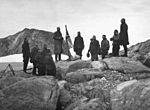






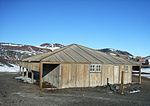



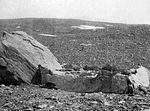
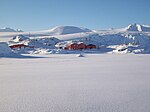
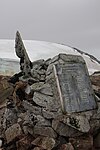
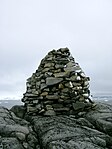
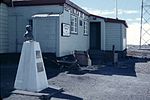



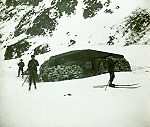
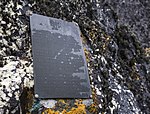




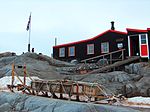


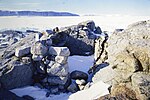

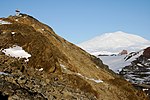

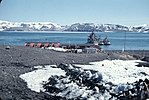
![Cape Denison, Commonwealth Bay, George V Land, East Antarctica. It is one of the most important sites of early human activity in Antarctica, which is also the base of the Australasian Antarctic Expedition 1911–1914, organized and directed by Douglas Mawson, and home to one of only six huts that remain the "heroic phase" of the conquest of Antarctica 1895–1917 is preserved. The historic site is also designated as a specially managed area of Antarctica ASMA-3 and, like this, includes the special Antarctic protected area ASPA-162. [Note 1]](https://upload.wikimedia.org/wikipedia/commons/thumb/0/00/Mawsons_Hut_at_Cape_Denison.jpg/150px-Mawsons_Hut_at_Cape_Denison.jpg)






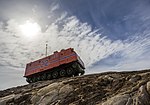

![Cross and memorial plaque on Cape Denison in George V Land, erected by Douglas Mawson on a hill 300 m southwest of the main house of the Australasian Antarctic Expedition from 1911 to 1914. The cross and the plaque commemorate the expedition members Belgrave Ninnis and Xavier Mertz, who Found their deaths during the expedition in 1913. [Note 1]](https://upload.wikimedia.org/wikipedia/commons/thumb/5/53/Memorial_cross_for_Mertz_and_Ninnis.jpg/99px-Memorial_cross_for_Mertz_and_Ninnis.jpg)

